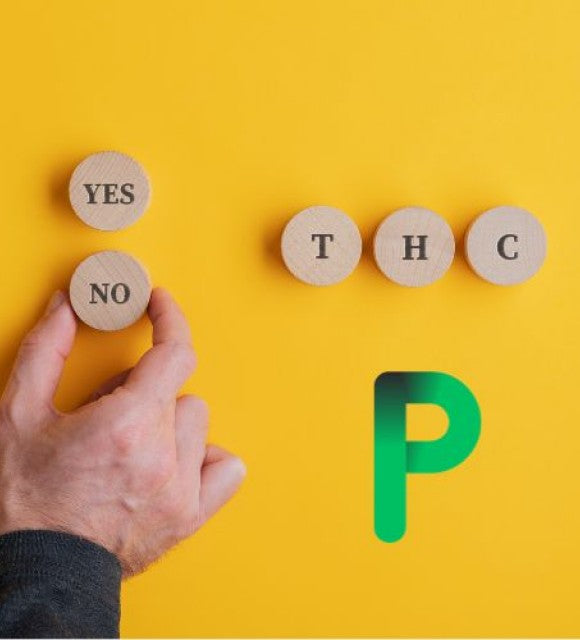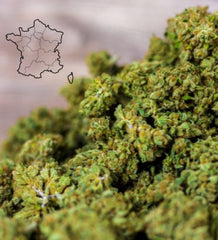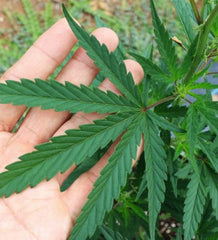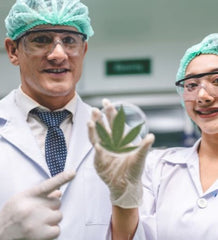
THCP: What is this new cannabinoid arriving on the French market?
THCP: One Cannabinoid Among Many Others
For the general public, the hemp plant is most often summed up as two highly publicized molecules: THC, a psychotropic substance, and CBD, a non-psychotropic substance packed with soothing properties. In reality, cannabis contains more than a hundred cannabinoids, and even though science is still trying to identify their characteristics, effects, and therapeutic potential, many civilizations have used the hemp plant for healing for millennia. Let's take a moment to delve into the (very) recent history of cannabinoids.
Once upon a time… there were cannabinoids!
To understand what a cannabinoid is, we need to analyze the etymology of the word. The term "cannabinoid" comes from the word "cannabis" to which was added the suffix "oid," which means "similar to" or "related to." Cannabinoids are chemical compounds related to the cannabis plant and are responsible for its many properties, whether positive, such as anti-inflammatory, analgesic, antioxidant, or soothing effects, or negative, such as psychotropic, euphoric, and intoxicating effects.
Despite the cannabis plant's place in the makeshift pharmacopoeias of many ancient civilizations, the "scientific" discovery of cannabinoids is relatively recent, dating back to the mid-20th century. THC was first isolated in 1964 by Israeli chemist Raphael Mechoulam and his colleagues. This discovery paved the way for the exploration of other cannabinoids and the understanding of their mechanisms of action, primarily for medical purposes. THCP, on the other hand, was discovered much later. We discuss this later.
THCP and other cannabinoids: structure and mechanism of action
Cannabinoids are made up of carbon, hydrogen, and oxygen atoms. They interact with the endocannabinoid system, which is a complex system of receptors and neurotransmitters distributed throughout the human body (and also in animals). This system regulates several bodily functions and conditions the way we feel pain, regulates our moods, our metabolism, our digestion, our sleep, and more. It is therefore a real metronome that directly affects our quality of life on a daily basis!
More specifically, cannabinoids bind to the CB1 and CB2 receptors of the endocannabinoid system to express different effects depending on their affinity and concentration. Research on these interactions is still ongoing, and each new discovery sheds more light on the "benefit-risk" relationship of these fascinating compounds!
Ancient civilizations, unaware of the science of cannabinoids, widely exploited the properties of hemp for a multitude of medicinal applications. Ancient texts from China and India report the use of cannabis to treat several ailments such as pain and digestive disorders. Today, modern science is beginning to understand why these treatments were effective.
But as you may have guessed, the hemp plant is not a rudimentary plant organism. It is a complex reservoir of compounds that have the potential to revolutionize modern medicine as well as the wellness and relaxation industry... especially in a world where stress and anxiety undermine the daily lives of several million people. According to IFOP , 95% of French people over 18 say they are "stressed or anxious." What role does THCP play in this joyful hemp circus?
THCP: A late-discovered cannabinoid
At the forefront of scientific exploration of cannabinoids, a "new" cannabinoid has emerged under the curious gaze of researchers specializing in the therapeutic benefits of the cannabis plant. THCP, or tetrahydrocannabiphorol, was first identified in 2019 by a team of Italian researchers, adding a new nuance to the already rich palette of cannabis.
This discovery is the result of a meticulous and targeted exploration of cannabis compounds by scientists from the University of Modena and the University of Salerno in Italy. Faced with the emergence of new cannabinoids and the need to better understand their properties to advance research, particularly in the management of stubborn pain associated with certain serious pathologies (cancers, multiple sclerosis, neuralgia, etc.), these researchers undertook to analyze hemp extracts from the Cannabis L. Sativa variety using advanced chromatography and mass spectrometry techniques.
THCP was isolated along with other cannabinoids, some of which were already known (CBD, CBG, CBN, CBC, THC), and others that were new. The surprise was great when analyses showed that THCP had up to 33 times more affinity with the "CB 1" receptors than THC.
The discovery of THCP was published in the journal Scientific Reports in December 2019, marking a significant milestone in the recent history of cannabinoids. It not only enriched our understanding of the complexity of cannabis, but also raised new questions and sparked renewed interest in exploring this fascinating plant, which has arguably been under-exploited by healthcare professionals. This gives THCP its place among the cannabinoids known to man.
THCP: focus on the chemical characteristics of this “new” cannabinoid
As its name clearly suggests, THCP is a compound similar to THC, but it has chemical differences that give it slightly different properties. Let's review the chemical specifics of this molecule to draw some conclusions and hypotheses.
Molecular Structure: THCP vs. THC
THCP has the molecular form C 23 H 32 O 2 , with a side alkyl chain of the "heptyl" type, therefore with 7 carbon atoms. This is relatively close to THC, which has the molecular form C 21 H 30 O 2 , but with a side alkyl chain of the "pentyl" type, with only 5 carbon atoms. This difference explains the high affinity of THCP for the "CB 1" receptors of the endocannabinoid system, mainly located in the brain (hence the psychotropic effect, but we will come back to this).
Affinity for “CB 1” and “CB 2” receptors
THCP's affinity for CB1 receptors is approximately 33 times greater than that of THC, which already has a high affinity for these receptors. This specificity is undoubtedly the highlight of the Italian researchers' work, as it could have major implications for the molecule's therapeutic potential.
THCP's increased affinity for CB1 receptors is a fascinating and complex topic spanning the fields of chemistry and molecular biology. We've combed through the scientific literature on this topic to present the most credible hypotheses to explain this unprecedented affinity. If you're not a chemistry and/or hemp enthusiast, you can skip this section:
- Alkyl chain length : The major difference between THC and THCP lies in the length of their side alkyl chains. THCP has a heptyl chain (7 carbon atoms) while THC has a pentyl chain (5 carbon atoms). Hypothesis : The longer chain could allow for better interaction with the CB 1 receptor, thus increasing the affinity of THCP. The heptyl chain could in fact fit more effectively into a hydrophobic region of the binding site, facilitating a more stable interaction;
- Conformation and flexibility : The three-dimensional structure of the molecule and its flexibility may affect how it binds to the receptor. Hypothesis : The specific conformation of THCP may be more compatible with the shape of the CB1 receptor binding site. This structural complementarity could facilitate and stabilize the interaction;
- Non-covalent interactions : Bonds between the molecule and the receptor may include hydrophobic interactions, hydrogen bonds, and Van der Waals forces. Hypothesis : The heptyl chain of THCP may form additional non-covalent interactions with amino acids in the CB 1 receptor. These interactions may strengthen binding, thereby increasing affinity;
- Influence of the binding site microenvironment : The CB1 receptor binding site is complex, and its microenvironment can affect how a molecule binds to it. Hypothesis : THCP may interact more favorably with this microenvironment, perhaps due to its structure or electrical charge. This could contribute to greater affinity for the receptor.
Stereochemistry of the THCP molecule
The THCP molecule contains isomers, molecules with the same chemical formula but different atom arrangements. These stereochemical variations can have different effects on the body and offer new avenues of exploration for medicine and pharmacology.
Synthesis and isolation of THCP
The isolation of THCP requires advanced chromatographic techniques. The chemical synthesis of this molecule, therefore, can be complex and requires delicate handling by experienced chemists.
THCP: Comparison with other cannabinoids
The structure of THCP differs from that of CBD, which remains THE mainstream cannabinoid due to the absence of any psychotropic or addictive effects, as explained by the World Health Organization (WHO). The heptyl chain gives THCP distinct properties, both in terms of receptor binding and its potential effect on the body.
Challenges and research perspectives around THCP
THCP, although similar to THC, presents unique research challenges. Its rarity in the cannabis plant and the complexity of its extraction and synthesis require advanced analytical methods. Furthermore, the clinical implications of its increased binding to CB1 receptors have yet to be fully investigated.
Potential therapeutic applications of THCP
The unique properties of THCP open up exciting prospects for medicine. Its increased affinity for CB1 receptors suggests therapeutic potential on several levels.
Pain management is arguably the potential application of THCP that has generated the most interest from the scientific community. Chronic pain, particularly that related to conditions such as fibromyalgia, arthritis, or nerve damage, is often difficult to treat with conventional medications. THCP's affinity for CB1 receptors may give it some ability to modulate pain signaling in the central nervous system. This could result in more effective pain relief without the unwanted side effects of opioids, such as addiction and the risk of overdose . It should be remembered that these drugs are responsible for 4 deaths per week and 7 hospitalizations per day in France, according to INSEE figures.
Inflammation is another area where THCP could have a significant therapeutic impact. Chronic, intractable inflammatory diseases, such as Crohn's disease, rheumatoid arthritis, and multiple sclerosis, may benefit from THCP's modulatory effect on CB1 receptors. Unlike nonsteroidal anti-inflammatory drugs (NSAIDs), which can have gastric side effects, THCP could offer a safer and more targeted alternative if used under strict medical supervision.
Finally, like all other cannabinoids, THCP may play a role in neurological disorders such as epilepsy and Alzheimer's disease. Its strong affinity for CB1 receptors may indeed influence neuroprotection and neuroplasticity. Let's close the scientific parenthesis and now address the legal status of THCP in France.
Despite its obvious psychoactive effect, THCP is… “legal” in France
On June 13, former Health Minister François Braun announced the ban on hexahydrocannabinol ( HHC ), a synthetic cannabis derivative, following its classification as a "narcotic" by the French National Agency for the Safety of Medicines and Health Products (ANSM). In the wake of this, consumers and suppliers have turned to other THC derivatives, including THCP and H4CBD, which remain "legal" in France today, in the sense that they are not classified as "narcotics." This legal gray area is causing concern and raising questions, including at Famous CBD.
Nicolas Authier, a doctor, explained to France TV Info: " These are poor copies of the chemical structure of THC, CBD, or both. Beware of the risks! A risk of dependence and addiction, but also of neuropsychiatric or cardiovascular complications. This is what puts some users in the hospital. These substances have not been studied enough, so the consumer becomes the guinea pig, and generally, the manufacturers forget to tell you this ."
For its part, the ANSM explains that these substances " are already under surveillance " and that " the expert assessment must deliver its conclusions before the end of the year ."
THCP: Famous CBD's position
At Famous CBD, your online store specializing in CBD and cannabinoid products, we make it a point not only to comply with the current law (products with less than 0.3% THC), but also to remain within the spirit of the law and not to take advantage of gray areas and business opportunities that exploit legal inconsistencies.
Our position regarding THCP is transparent and aligned with our company values. While this cannabinoid has generated some scientific and medical interest, it is not a component of our products. We understand the complexity of cannabinoids and recognize the need for a cautious approach in a rapidly evolving regulatory landscape.
At Famous CBD, our mission is to offer quality CBD and cannabinoid products that meet standards that exceed those required by law. We advocate trust, safety, and reliability, and we are committed to monitoring legislative and scientific developments in this area to inform you and guide our offerings, which must always reflect our commitment to helping you discover CBD with complete peace of mind.





